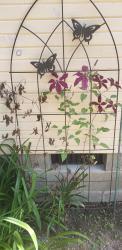Thank you for that suggestion. I AM removing 1/2 of the daylily plants (those in closest proximity), but I should've pointed out, this clematis probably gets on the "too much", rather than "too little" water side. It's on a downgrade along the side of our home & the water (when it rains) runs down (along with sandy silt) over those plants, almost at an alarming rate. I do not have anything protective (ie: mulch) around the crown, however, & I'm reading that could be a factor. I will hopefully get a bag of mulch tonight.


